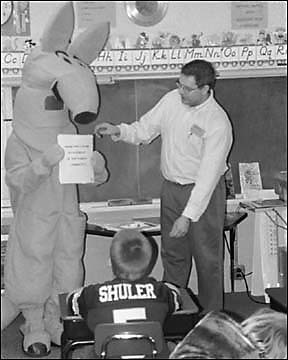 She also compared jars of candy with jars of medicine and a jar of cleaner with a jar of apple juice. "There are lots of things that look good or smell good that really are poisonous," she said.
She also compared jars of candy with jars of medicine and a jar of cleaner with a jar of apple juice. "There are lots of things that look good or smell good that really are poisonous," she said.Holly Elg, a pharmacy student spending ten weeks at the Paynesville Area Health Care System, conducted a demonstration with each kindergarten class separately. "Poisons are bad," she told the students. "Poisons can hurt you. They can make you sick."
Elg explained to the students that poisons come in four forms: solids, liquids, sprays, and invisible.
Not all poisons are things we eat or drink, she added. "Although this might smell good," Elg said while holding an air freshener, "if you were to get this in your eyes or breathe it, it might hurt you."
Bug spray also can be a poison if it gets in your eyes or mouth rather than on your skin, she explained.
The students played a game in which they had to identify items as either safe or potentially poisonous.
To demonstrate how easily poisons can be mistaken for common items, Elg held two jars in front of the students. One jar contained bleach and the other just water. Elg asked the students which one was safe to drink? They knew not to drink the bleach, but couldn't tell which was the bleach.
 She also compared jars of candy with jars of medicine and a jar of cleaner with a jar of apple juice. "There are lots of things that look good or smell good that really are poisonous," she said.
She also compared jars of candy with jars of medicine and a jar of cleaner with a jar of apple juice. "There are lots of things that look good or smell good that really are poisonous," she said.
"You always want to check with an adult if you're not sure," she added.
Elg also reviewed the green Mr. Yuk sticker that the Minnesota Poison Control System distributes so families can identify poisons around their house. Elg told the students that Mr. Yuk looks mean because he wants them to stay away. He is green because if they take a poison they will likely be sick.
If someone is poisoned, Elg told the students to either call an adult, 911, or the Minnesota Poison Control System at 1-800-764-7661. Their phone number, better remembered as 1-800-POISON 1, is on the green Mr. Yuk stickers, and Elg urged the students to put a sticker by the phone so they could call in an emergency.
Also last week, Elg and Todd Lemke(pictured with his assistant, Katie the Kangaroo), a Pharm.D. resident at PAHCS, visited with the second grade students to stress the importance of taking medicine correctly. They told the students to take medicine meant only for them, never to take old medicine, and to consult an adult if confused.
Poison Prevention Week
National Poison Prevention Week was from March 19 to 25. "People of all ages are at risk for unintentional poisoning," said Julie D'Ambrosio, Pharm.D., of the Minnesota Society of Health-System Pharmacists. "Every day thousands of children are exposed to poisons and every year dozens of these children die. Children are at risk due to their curiosity and capacity to explore and experiment; elderly are at risk due to their improper use of products, medications, or household cleaners. Virtually all poisonings are preventable. Simple safety measures can save lives."
According to their safety guide, the Minnesota Poison Control System handles 58,000 exposures to poison each year. Over half occur in children under the age of six. Most poisons occur at home. Medications, household cleaning items, and insecticides are the most common causes of poisoning deaths.
The Minnesota Poison Control System says that most poisonings happen at home because products are poorly stored, because children are curious, because children mistake poisons for safe items, and because children want to imitate adults by taking medications and doing household chores.
To prevent poisonings, the Minnesota Poison Control System recommends making your home poison proof by storing potential poisons in safe areas, by using child-resistant caps, by storing products in their original containers to avoid confusion, by using Mr. Yuk stickers, and by reading labels and following instructions.
With swallowed poison, the Minnesota Poison Control System advises to remove anything in the mouth and, unless the victim is unconscious, having a seizure, or unable to swallow, to give a couple ounces of water to drink.
With poison in the eye, you should gently flush the eye for ten minutes using medium warm water poured from a clean cup three inches above the eye.
With poison on the skin, contaminated clothing should be removed and large amounts of water used to rinse the skin.
For inhaled poison, the Minnesota Poison Control System recommends getting fresh air and avoiding fumes. After initial treatment, they want victims to call their hot line at 1-800-POISON 1. Do not wait for symptoms.